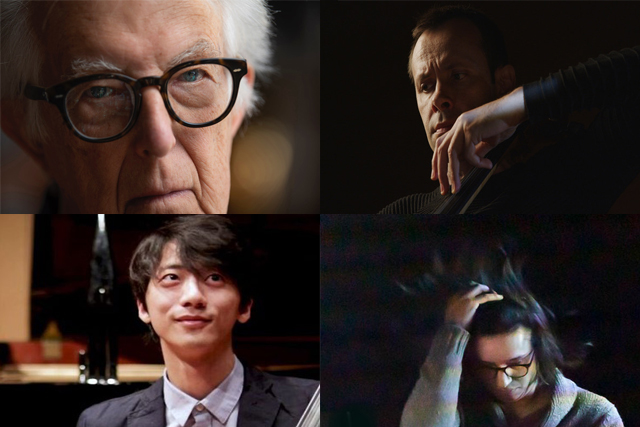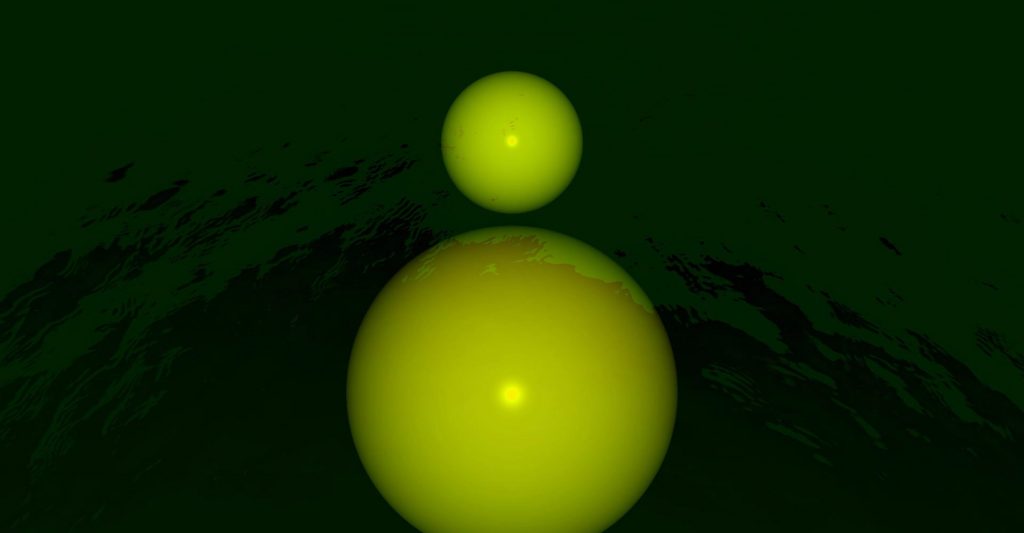
MARCH 30, 2023
PERSISTENCE
Roger Reynolds, Peter Ko, Jacob Sundstrom, Alexis Descharmes
- Thursday, March 30, 2023
- 5:00pm - 8:00pm Calit2 Auditorium
- Announcement
- Photos
- Video Stream
- RSVP to ideasqi@ucsd.edu
DETAILS:
This IDEAS performance features UC San Diego Professor Emeritus of Music Roger Reynolds, a Pulitzer prize-winning American composer known for blending traditional music with sounds newly enabled by technology. In “PERSISTENCE,” Reynolds; Miller Puckette, UC San Diego Distinguished Professor Emeritus of Music; Peter Ko and Alexis Descharmes, cellists; and Jacob Sundstrom, composer in computer music, showcase a live cello performance in conversation with technology. A six speaker system allows for a more immersive experience in Atkinson Hall’s auditorium.
Bios
Roger Reynolds is known for his integration of diverse ideas and resources, and for seamlessly blending traditional musical sounds and those now enabled by technology. His work responds to texts both poetic (Beckett, Borges, Stevens, Ashbery, Dickinson) and mythological (Aeschylus, Euripides, Heraclitus). He is noted for “wizardry in sending music flying through space: whether vocal, instrumental, or computerized”[ TheVillage Voice]. In 1969, Reynolds accepted a tenured appointment at UC San Diego and helped establish its Music Department as a destination program. Reynolds won early recognition with Fulbright, Guggenheim, and National Institute of Arts and Letters Awards, and also grants from the Rockefeller Foundation, and a Fellowship from the Institute for Current World Affairs. In 1989, Reynolds won the Pulitzer Prize in Music for the string orchestra composition, Whispers Out of Time. His over 150 compositions are published by Edition Peters, New York; several dozen CDs and DVDs of his music have been commercially released; and he is author of five books and numerous journal articles and chapters, some of them the result of collaborations with American, Canadian, and French scientists. Other collaborators have been choreographers Lucinda Childs and Bill T. Jones, as well as theater directors Tadashi Suzuki (Shizuoka, Japan) and Tina Parker (Massachusetts and London). His performer partners have included Irvine Arditti (London), The Arditti Quartet, Steven Schick (San Diego), Yuji Takahashi (Tokyo), Alexis Descharmes (Burgundy), Pablo Gómez Cano (Encinada), Anthony Burr (San Diego), Eric Huebner (Buffalo/New York), and Jacqueline Leclair (Montréal). In 2009 Reynolds was appointed University Professor — the first artist to be so honored in the University of California system’s history. In 1998, the Library of Congress established a Special Collection of his work. His scores and correspondence are also included in the Paul Sacher Collection in Basel, Switzerland. Reynolds has held guest appointments at Harvard, Yale, Amherst, University of Illinois, Darmstadt, Sibelius Academy, and CUNY. Reynolds has received commissions from the Philadelphia, Los Angeles, San Diego, and National Symphony orchestras, the French Ministry of Culture, the Suntory Foundation, The BBC Proms Festival, the British Arts Council, and the Siemens Foundation. Reynolds will be inducted into the American Academy of Arts and Letters in May.
Miller Puckette is a UC San Diego Distinguished Professor Emeritus of Music and former associate director of the Center for Research in Computing and the Arts. He was a member of MIT’s Media Lab from its inception until 1987, and then a researcher at IRCAM (l’Institut de Recherche et de Coordination Musique/Acoustique), founded by composer and conductor Pierre Boulez. At IRCAM he wrote Max, a widely used computer music software environment, released commercially in 1990 and now available from Cycling74.com. Puckette is also the author of Pure Data (Pd), a real-time performing platform for audio, video and graphical programming language for the creation of interactive computer music and multimedia works, written in the 1990s with input from many others in the computer music and free software communities. Puckette obtained a Bachelor of Science in Mathematics from MIT (1980) and a Ph.D. in Mathematics from Harvard (1986), winning a National Science Foundation graduate fellowship and the Putnam Prize Scholarship.
Peter Ko is a cellist, active performer and teacher pursuing his Doctor of Musical Arts at UC San Diego. As a performer, his training and projects have taken him across the United States, Mexico, Canada and Europe. His collaborations with other renowned musical artists include work with Mark Fewer, the Dover String Quartet, Steve Schick, Aleck Karis and Charles Curtis. Ko has performed at the soundSCAPE music festival in Italy, with the Palimpsest ensemble, and currently serves as principal celllist for the La Jolla Symphony and Chorus. He holds a Master of Music from Memorial University of Newfoundland, and a Bachelor of Arts from UC San Diego.
Jacob Sundstrom is a composer and UC San Diego Ph.D. candidate whose work has branched out into several mediums and fields including new media, installation and data-driven art. His musical work has been performed by ensembles including Inverted Space, the JACK Quartet and the Seattle Chamber Players. It has been performed or played in places as diverse as Radiophrenia in Scotland, art galleries and underground venues in Seattle, and the National Gallery of Art (Washington, D.C). As a researcher, Sundstrom has helped develop brain-computer musical interfaces for use in performance settings and novel spatialization algorithms. His work has been published in Frontiers in Human Neuroscience and his spatial work in IEEE.
Alexis Descharmes is an active ambassador of numerous cello repertoires and one of about eleven members of his generation to be selected by “Diapason” magazine as a representative of the French cello. Born in 1977, and trained at the Paris Conservatoire, Descharmes was the winner of the Valentino Bucchi (1997) and Avant-Scènes (1999) competitions. He has been supported by various foundations (Fondation Jean Brizard, Fonds Instrumental Français, Fondation Meyer, Mécénat Musical Société Générale and Fondation Natexis), and worked in the Ensemble Intercontemporain, Ensemble Alternance and Ensemble Court-circuit. He collaborates regularly with IRCAM on many projects. The dedicatee of some fifty contemporary works, concertante and solo alike, Descharmes’s discography consists of some twenty recordings, in solo or with ensembles with which he has appeared at numerous festivals and in some thirty countries. Descharmes joined the Orchestra of the Paris National Opera in 2006. Since 2004, he has collaborated regularly with the French Embassy in Washington, D.C. for the Contemporary Music Series of La Maison Française. He became a member of the NGA New Music Ensemble in 2010.




